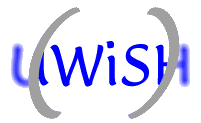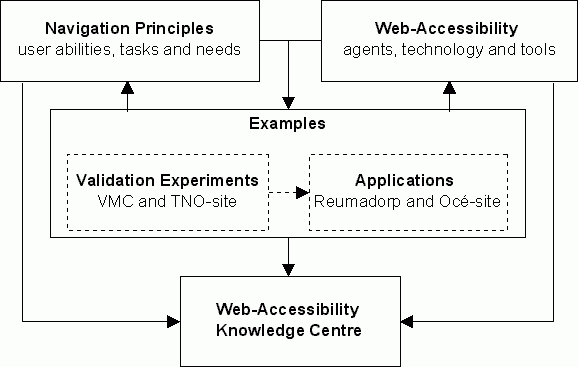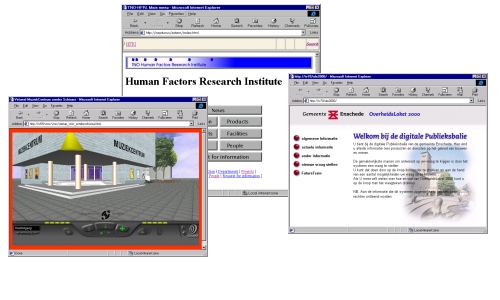UWISH: Usability of Web-based Information Services for Hypermedia


Contents
Objective
Keywords
Overview
Some interim results
Publications
General Resources
Partners
Contractor
Contact
Objective
Development of a user-centred design method for Web-based services that guides the iterative process of software development. Advocating the "design for all" approach, specific attention is paid to the accessibility for elderly.
Keywords
Network user interface, adaptive interface, World Wide Web, user-centred design, usability testing, multimedia, hypertext
Overview
The general objective of U-WISH is to improve the accessibility of Web-based information services for hypermedia by
- developing design principles for navigation support
- addressing and developing techniques and tools for enhancing the accessibility
- applying and assessing the principles, techniques and tools
- sharing the acquired knowledge via a Web-based service
Figure 1 presents an overview of the UWISH-project. Navigation principles and "Web-accessibility" techniques are being developed, applied and evaluated for different example services. A "Web-accessibility" knowledge centre is being designed to make the acquired knowledge accessible and to share the expertises (in the original UWISH project plan called "handbook").

Figure 1: Overview of the U-WISH project.
First year
In the first year, the foundations for the design of Web-navigation support were developed. First, we identified crucial cognitive factors that affect effectiveness, efficiency and satisfaction in navigation tasks: spatial ability, memory capacity and situation awareness. Based on these factors, we derived user requirements for navigation support and mapped them on the support functions that current Web-interfaces provide. Subsequently, three new promising support concepts were specified and implemented: categorising landmarks, history map and navigation assistant. Software tools were developed for the assessment of usability (i.e. TIATO), and for the testing of spatial ability and memory.
Second, we developed a technique for specifying interactive web-based systems. This specification technique, which is based on process algebra, allows for the description of systems (or rather parts of systems) in which virtual reality, software agents, interactive processes, and multi-modal dialogues (including speech and natural language as possible modalities of interaction) may occur. This technique should help to transform the results of a task analysis into a prototype interface.
Second Year
In the second year of the U-WISH project, the foundations for the design of Web-navigation support were tested and compared to the design practice. Based on the go/nogo review, the focus of the U-WISH project was set on the three navigation support concepts and the cognitive engineering techniques to develop the support functions (i.e. for universal accessibility, the specification of the navigation assistant and usability testing). In this way, the project is innovative, current usability guides and handbooks do insufficiently provide well-founded solutions for adequate navigation in Web-based services by users with different navigation skills. The U-WISH project identifies important cognitive factors that determine navigation performance, derives guidelines for navigation support, develops enhanced support concepts and develops techniques to design multi-modal, multi-agent Web-based services for information and commerce that include the support functions. These support concepts extend individual capacities of Web-users, in particular the spatial, memory and task-switching capacities, contributing to the implementation of "Design for all" or "Universal Accessibility". In order to attune U-WISH to the companies' needs, we investigated current and future Web-design activities at Océ and Rabofacet (the analysis at KPN has to be completed yet). The analyses of the companies provide further information about which U-WISH results can be applied when and where in the development process of (future) Web-based services, and requirements for a "Web-accessibility knowledge centre". This activity resulted in a more extensive participation of the companies in the U-WISH project.
As a first step in the production of the "general part"of the knowledge-centre's content, we developed a tutorial. The tutorial was given for a dutch and an international public so that we could acquire general feedback on its content from different interested persons. We refined the navigation theory and corresponding cognitive tests. A first test showed that the theory can, among other things, explain usage problems of elderly. We developed a navigation assistant for VMC and the "TNO HF site", and succeeded to implement the same navigation concept with the same "look and feel"for these completely different Web-based services. The test showed that the technology "worked" and that users would like to have this kind of support. However, improvements are required for actual accessibility profits. KPN, TNO and the "Reumafonds" made plans to develop navigation support for the 'virtual community' www.reumadorp.nl. Rabofacet and Reumafonds explored the possibility to add a banking service to this community. Océ and TNO started with a plan for navigation support in the Océ-site. Based on the first TIATO-version, the UWISH companies provided requirements for redesign, and TNO, Satama en Noldus made plans for further development of TIATO.
Third year
In the third year, the U-WISH research will be completed and made accessible for the Telematics Institute. Section 2 provides the work plan that consists of the following elements:
- We will complete the requirements for and the content of the "Web-accessibility knowledge centre" and develop this Web-based service. In a workshop, the U-WISH results will be presented and discussed, in particular focused on their implementation and further improvement of the Web-usability engineering practice.
- We will further validate the practical theory of Web-navigation, improve the design of the navigation support functions for VMC and the TNO-HF site, and subsequently evaluate these functions with young and elderly users. Furthermore, navigation support will be developed and, subsequently, assessed for the Océ site and the Reumadorp "virtual community".
- We will provide an approach of how to design and implement the navigation assistant with current Web- and agent-technology.
- We will work on the exploitation of the U-WISH results: in particular the development of TIATO into a better product and the implementation of the navigation support concepts.
Some interim results
- An overview of current usability guidelines that apply to the "design for all" approach.
- Design of four types of interface adaptations (sitemap, history map, assistant and landmarks).
- A generic test environment to evaluate a variety of web-based services and interface adaptations on effectiveness, efficiency and satisfaction.
- Reliability and validity measures of structured walkthrough technique to assess interfaces.
- Formal specification of the three Web-services.
- Design of tutorial/workshop: "Improving navigation in Web-based services".

The three test environments: theatre booking service, public counter, and company web-site
Publications
Papers
- Van Schooten, B.W., Donk, O.A., Zwiers, J. (1999) Modelling Interaction in Virtual Environments using Process Algebra. In Proceedings TWLT 15: Interactions in Virtual Worlds, Enschede 1999 May 19-21
- Nijholt, A. e.a. (1999) The Twente Virtual Theatre Environment: Agents and Interactions. In Proceedings TWLT 15: Interactions in Virtual Worlds, Enschede 1999 May 19-21
- Lindenberg, J. & Neerincx, M.A. (1999). A generic usability test environment for web-based services. In Proceedings "Ergonomie in uitvoering" Conference", The Netherlands, November, 12-13.
- Neerincx, M.A. & Lindenberg, J. (1999). Supporting individual situation awareness in Web-environments. In Proceedings "Ergonomie in uitvoering" Conference", The Netherlands, November, 12-13.
- Lindenberg, J. & Neerincx, M.A. (1999). The need for a 'universal accessibility' engineering tool, Interact '99, 1999.
Reports
- M.A. Neerincx, S. Pemberton, J. Lindenberg, NJP van Besouw, Attuning Network User Interfaces to individual capacities: User requirements and support concepts., TNO report. Abstract.
- M.A. Neerincx, S. Pemberton, J. Lindenberg, Web usability: methods, guidelines and support interfaces., TNO report. Abstract.
General Resources
Styleguides
Examples of styleguides and other resources are:
- http://info.med.yale.edu/caim/manual/contents.html
- http://www.sun.com/styleguide/index.html
- http://www.usability.serco.com/nonframe/web.html
- http://www.useit.com
- http://www.ameritech.com/corporate/testtown/library/standard/web_guidelines/
- http://msdn.microsoft.com/workshop/management/planning/improvingsiteusa.asp
- http://www.ibm.com/ibm/easy/design/lower/f060100.html
- http://www.killersites.com/core.html
- http://trace.wisec.edu (focussed on 'Universal Accessibility')
- http://www.w3.org/TR/WAI-WEBCONTENT/ (focussed on 'Universal Accessibility')
- http://www.nomos.se/wammi/: Web Usability Questionnaire
- http://www.lap.emd.edu/webnet/paper.html: Questionnaire administration
- http://www.lap.emd.edu/quis/: Questionnaire for User Interaction Satisfaction
Resources on International and Cultural Issues
- An excellent collection of resources: http://www.acm.org/sigchi/intercultural/
- The World Wide Web Consortium's internationalisation work: http://www.w3.org/International/
- A good book: International User Interfaces, edited by Elisa del Galdo and Jakob Nielsen, published by John Wiley & Sons, New York, NY, 1996. ISBN: 0-471-14965-9 (hardcover).
- Another good book: Global Interface Design, Tony Fernandes, Academic Press, 1995, ISBN 0-12-253790-4
Technology that can be used to aid usability
- Check your pages for accessibility at: http://www.cast.org/bobby/
- CSS: http://www.w3.org/Style/CSS. It lists known books about CSS, online resources, supporting browsers, and editors.
- The CSS1 Recommendation is at http://www.w3.org/TR/REC-CSS1
- The CSS2 Recommendation is at http://www.w3.org/TR/REC-CSS2/
- XHTML is at http://www.w3.org/TR/xhtml1/ with more information at http://www.w3.org/Markup
- XML is at http://www.w3.org/TR/REC-xml with more information at http://www.w3.org/XML/
- An excellent book on CSS2, is by two of its creators, Håkon Lie and Bert Bos. It is Cascading Style Sheets: Designing for the Web, published by Addison-Wesley.
- http://jigsaw.w3.org/css-validator/ will validate your CSS.
- http://validator.w3.org/ will validate your HTML and XHTML
- http://www.xml.com/xml/pub/tools/ruwf/check.html will check your XML for well-formedness.
- http://www.w3.org/People/Raggett/tidy/ will tidy up your HTML, making it more amenable for CSS, and convert it to XHTML 1.0
- http://www.w3.org/Style/CSS/Test/ lets you test your browser for CSS compliance
- http://www.w3.org/StyleSheets/Core/ is a set of style sheets for HTML designed by a graphic-designer
- http://webreview.com/pub/guides/style/style.html keeps track feature by feature of how well (or badly) browsers implement CSS.
- http://webreview.com/wr/pub/guides/style/lboard.html shows which browser is doing best overall.
- http://css.nu/pointers/bugs.html offers workarounds for browser bugs.
General articles about specification techniques
- J.C. Campos and M.D. Harrison. Formally verifying interactive systems: A review. In Proceedings of the Eurographics workshop '97, pp. 109-124. Springer-Verlag, Wien.
- D.J. Duke and M.D. Harrison. From Formal Models to Formal Methods. In Proceedings of ICSE'94 workshop on SE-HCI. pp. 159-173. Lecture Notes in CS 896. Springer, 1995.
- A. Hall. Do interactive systems need specifications? In Proceedings of the Eurographics workshop '97, pp. 1-12. Springer-Verlag, Wien.
Task analysis and GTA
- Sutcliffe and P. Faraday. Designing Presentation in Multimedia Interfaces. In Proceedings ACM CHI'94. pp. 92-98.
- G.C. van der Veer, B.F. Lenting and B.A.J. Bergevoet, Groupware task analysis: Modeling Complexity. Acta Psychologica, 1991.
- GTA Homepage: http://www.cs.vu.nl/~martijn/gta
Examples of the use of GOMS
- B. E. John, A.H. Vera and A. Newell. Towards Real-Time GOMS. Report, CMU-CS-90-195, Carnegie Mellon, Pittsburgh, 1990.
- J. Ziegler and H-J. Bullinger. Formal Models and Techniques in Human-Computer Interaction. In Human Factors for Informatics Usability. pp. 183-205. Cambridge University Press, 1991.
Explanation of the use of Z
- J. Woodcock and J. Davies, Using Z - specification, refinement, and proof, Prentice Hall Europe, 1996.
CSP
- C.A.R. Hoare, Communicating sequential processes, Prentice-Hall International, 1985.
Executable specifications for interactive systems
- B. van Schooten, O. Donk and J. Zwiers. Modelling Interaction in Virtual Environments using Process Algebra. In Proceedings TWLT15, Interactions in Virtual Worlds, pp. 195-212. Twente University, 1999.
Partners
Research institutes
Mark Neerincx en Jasper Lindenberg, TNO Human Factors Research Institute
Betsy van Dijk en Anton Nijholt, CTIT-CDS, Universiteit Twente
Steven Pemberton, CWI



Companies
JJ de Graaff, KPN Research
KJ Wierda, Océ
PJM Eikelboom, Rabobank



Contractor
Telematics
Institute
Coordination: Rene Bal

UWISH Site at the Telematics Insititute
Contact
Project manager and contact person: Mark Neerincx
Email address of all research institute partners:
uwish-ki-list@cwi.nl
Email address for all partners:
uwish-list@cwi.nl
Last modified: Mon Mar 19 14:19:40 CET 2001